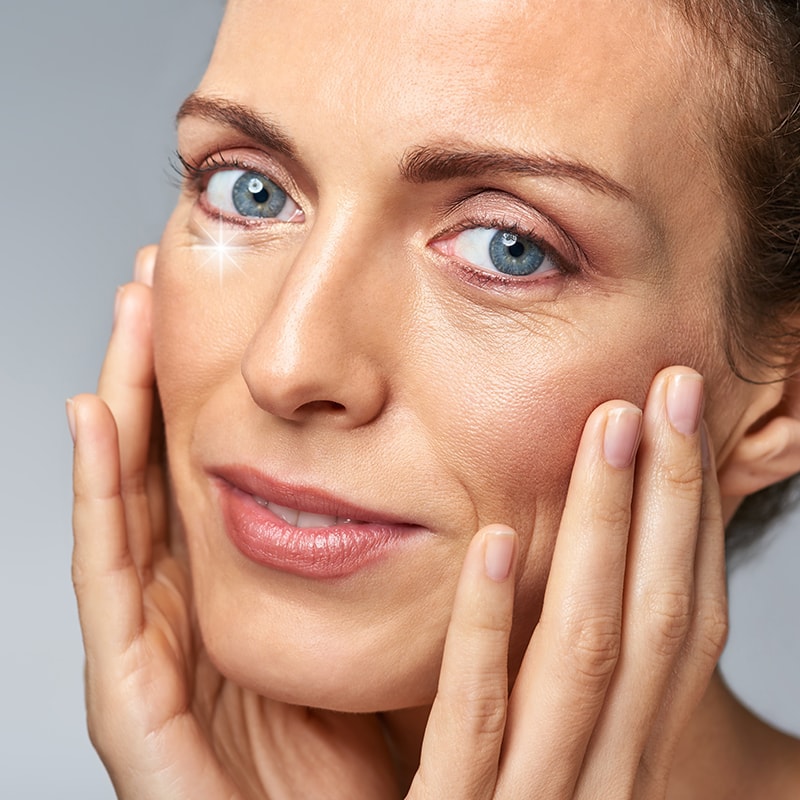Home » Beautification » Under Eye Area
Under Eye Area
Table of Contents
What are the effects of aging on the under eye area ?
 The under-eye area is particularly susceptible to the visible signs of aging due to its delicate and thin skin. The effects of aging on the under-eye area can include:
The under-eye area is particularly susceptible to the visible signs of aging due to its delicate and thin skin. The effects of aging on the under-eye area can include:
- Fine Lines and Wrinkles: The skin around the eyes is thinner and more delicate than the skin on the rest of the face. As collagen and elastin production decrease with age, fine lines and wrinkles can develop, especially around the corners of the eyes (crow’s feet) and under the eyes.
- Loss of Volume: The under-eye area may experience a loss of volume as a result of reduced fat and collagen, contributing to a hollow or sunken appearance. This volume loss can make dark circles and bags under the eyes more noticeable.
- Dark Circles: Dark circles under the eyes can be caused by various factors, including genetics, thin skin, and vascular changes. Aging can exacerbate the appearance of dark circles as the skin becomes thinner and blood vessels may become more visible.
- Puffiness and Bags: The formation of bags or puffiness under the eyes can be influenced by a combination of factors, including fluid retention, fat accumulation, and weakening of the support structures in the under-eye area. These changes can become more prominent with age.
- Crepey Skin: The skin under the eyes may become thinner and develop a crepey texture as collagen and elastin fibers break down. This can contribute to a more aged and tired appearance.
- Sun Damage: Sun exposure is a significant contributor to premature aging. The under-eye area is often exposed to the sun, and UV rays can lead to the breakdown of collagen and elastin, causing accelerated aging and the development of fine lines and wrinkles.
- Expression Lines: Repetitive facial expressions, such as squinting or smiling, can contribute to the formation of lines and wrinkles around the eyes over time.
What are the treatment options for the under eye area?
Addressing the effects of aging on the under-eye area may involve various preventive measures and cosmetic interventions, including:
- Sun Protection: Regular use of sunscreen and wearing sunglasses with UV protection can help prevent sun damage and reduce the risk of premature aging around the eyes.
- Topical Skincare: Using moisturizers, eye creams, and serums containing ingredients like retinoids, hyaluronic acid, and antioxidants can help improve skin texture and reduce the appearance of fine lines.
- Dermal Fillers: Injectable fillers, such as hyaluronic acid fillers, can be used to restore volume and reduce the appearance of hollowing under the eyes.
- Cosmetic Procedures: Treatments like chemical peels, laser therapy, or microneedling may be employed to improve skin texture and reduce pigmentation issues. Lower eyelid surgery is also among the rejuvenation options.
- Eye Creams: Specialized eye creams can provide hydration and may contain ingredients targeted at reducing puffiness, dark circles, and fine lines.
For more significant concerns, individuals may consider surgical interventions such as blepharoplasty (eyelid surgery) to address loose skin, excess fat, or bags under the eyes. Consulting with a dermatologist or a qualified skincare professional can help determine the most appropriate approach based on individual needs and goals.
Do under eyes get darker with age?
Yes, the under-eye area can appear darker with age, and there are several reasons for this phenomenon:
- Thinning of Skin: The skin under the eyes is thinner and more delicate compared to the skin on other parts of the face. As individuals age, the skin can further thin due to a reduction in collagen and elastin production. Thinner skin can make blood vessels beneath the surface more visible, contributing to a darker appearance.
- Loss of Fat and Volume: Aging often involves a loss of fat and volume in various facial areas, including the under-eye region. This loss of volume can create a hollow or sunken look, and the contrast between the hollows and the surrounding areas can make dark circles more noticeable.
- Increased Transparency: With age, the skin under the eyes may become more transparent. This transparency can reveal the underlying structures, such as blood vessels and blood pooling, contributing to the appearance of dark circles.
- Sun Exposure: Prolonged exposure to the sun’s harmful UV rays can lead to pigmentation changes in the skin. The under-eye area, being thin and sensitive, is particularly vulnerable to sun damage, which can result in hyperpigmentation and contribute to dark circles.
- Genetics: Genetic factors play a role in determining an individual’s predisposition to certain skin characteristics, including pigmentation. If family members have dark circles, there may be a genetic component influencing their development.
- Fluid Retention: Poor circulation and fluid retention around the eyes can contribute to the appearance of puffiness and dark circles. Age-related changes in blood circulation and lymphatic drainage can exacerbate this issue.
- Lifestyle Factors: Certain lifestyle factors, such as lack of sleep, stress, smoking, and a poor diet, can contribute to the appearance of dark circles under the eyes. These factors may become more prevalent with age and can worsen the overall condition of the under-eye area.
While aging is a natural process that can contribute to dark circles, various preventive measures and treatments can help minimize their appearance. Using sun protection, maintaining a healthy lifestyle, getting adequate sleep, staying hydrated, and using skincare products with ingredients like vitamin C, retinoids, and hyaluronic acid can be beneficial. Additionally, cosmetic interventions such as dermal fillers or topical treatments targeting pigmentation may be considered to address dark circles more directly.

